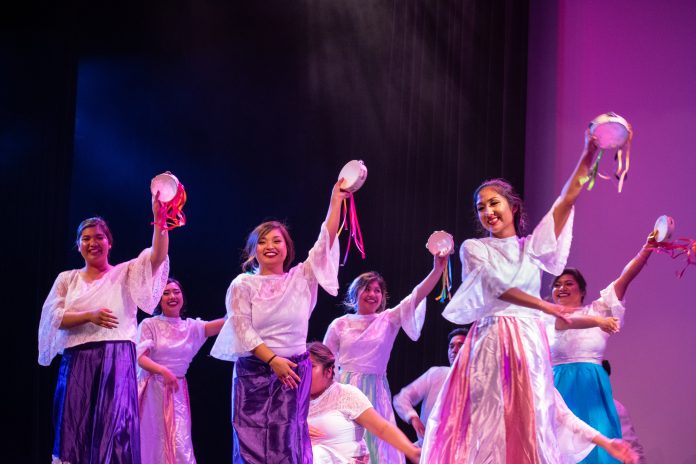Jennica Martin
Staff Writer
Last Saturday, UCSB’s Kapatirang Pilipino hosted its 27th annual Pilipino Culture Night (PCN), entitled “’Til Next Time,” to hundreds of screaming and cheering audience members at Campbell Hall. Pilipino Culture Night is a celebration of Filipino culture that also discusses issues within the community through the use of a play and traditional dances.
Despite imperfections with the play, well-choreographed dance numbers made up for it, and the performances remain an important part of many UCSB students’ lives and Filipino-American culture.
The show “’Til Next Time” follows the lives of the Bautista siblings: Naomi, an aspiring filmmaker and undocumented college student living in the U.S., and Matthew, a struggling journalist living in the Philippines. They both struggle with being separated for nearly a decade after their parents moved to the U.S. and also struggle under the current political circumstances of their respective countries.
This show takes on a more political route than the previous PCNs by addressing both the election of Donald Trump as president as well as the election of Rodrigo Duterte in the Philippines. It makes comparisons between the two of them, criticizing Trump’s disparaging attitude towards immigrants and Duterte’s policies regarding his brutal and escalating drug war.
It also connects these real life issues to the main struggles that the characters face. Naomi constantly lives in fear of her undocumented status potentially being discovered and her life being disrupted after the attempts to repeal DACA, while Matthew constantly tries but fails to bring attention to unjust crimes and murders linked to the drug war. The show addresses these issues in a respectful way, but it was a bit tame and could have been stronger and more impactful with its criticism.
Overall, the stage play had an interesting premise, but the dialogue was cheesy, the plot was predictable, and the acting was very melodramatic. The dialogue was filled with awkward references to pop culture and the plot borrowed storylines seen in every soap opera, like using the sudden, tragic death of a family member as a plot twist.
However, cheesy dialogue and clichéd storylines are things you’d expect from every PCN, because the goal of these shows is not to make an award-winning show, but to expose people to Filipino culture and allow them to think about different social issues.
That is why the dance performances are arguably the best part of the show. The transitions between the stage play and the performances were sudden and jarring, with little to no connection between them, but the dance performances still stood out. Past PCN dance performances have been more extravagant, but the show was still well choreographed for this show.
The performances that stood out to me were the Hinang-Hinang, or the fisherman dance, and the Pandango Sa Ilaw, or the Dance of Lights. During the Hinang-Hinang performance, people balanced precariously on top of bamboo sticks while others danced underneath them. In Pandango Sa Ilaw, the dancers gracefully balanced three candles on their heads and hands as they moved, which ended up being a visually beautiful performance.
The most famous and popular traditional Filipino dance, Tinikling, was also very memorable. It is a great example of saving the best for last, with dancers quickly and energetically maneuvering around moving bamboo sticks. It was the dance that got the loudest and most intense round of applause from the audience.
If you’ve been to a PCN before, then you would already know that the audience is a character of its own. Members cheer for their friends and family members on stage, often cheering loud enough to drown out the music. The audience contributes to the energetic vibe of the show.
“’Til Next Time” was an entertaining show that leaned a bit too heavily on clichés and melodrama. However, the amount of effort and work put into this show shone through and ended up being a great celebration of Filipino culture, forming a nice addition to the growing history of Pilipino Culture Nights.











